A great impulse to anatomical studies was given by the reappearance of the nude in art in the Renaissance and by the desire of sculptors and painters to know the structure of the human body, in order to represent it in an increasingly realistic way. Among these we distinguish the brilliant figure of Leonardo Da Vinci, which sums up the highest elements of our lineage even five centuries later. 500 years later, in the international year dedicated to Leonardo, it is incredible to think how much his analytical and creative genius has intuited and anticipated many truths that seem to be conquests of today’s times. Da Vinci knew how to move easily from the anatomical knife to the brush, from the study of science to the methodical and objective investigation of natural phenomena, from small and large mechanical applications useful for life to the highest expressions of art and sculpture.
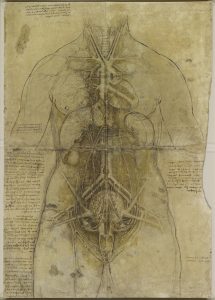
Leonardo was, before Vesalius, the true creator of the scientific method in anatomy. The exercise of art had to be based on solid theoretical preparation for him. Da Vinci warned the artisans who “fell in love with the practice without science”. Experience is for Leonardo the means to discover the general law of nature, a law that is also found in the principle of causality. Leonardo’s gaze was that of a scientist, an artist, a man who knew how to gather assonances between the different elements of nature and create unique metaphors, characterized by a rare interdisciplinarity, even today.
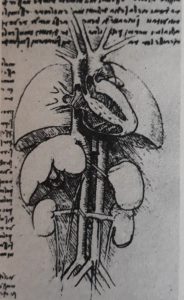
One of the most beautiful metaphors he created was precisely between water and the circulatory system: the water present on the Earth is not infinite, so what is brought from the rivers to the sea must somehow return to the source, that is by making a continuous cycle. And as water nourishes the planet, blood feeds the human body, through the veins and arteries.
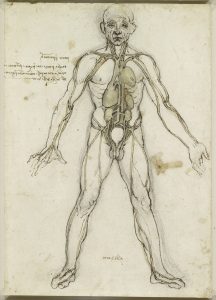
As it was for Leonardo, the close connections of the heart with life have for centuries attracted scholars and thinkers to finally arrive at the knowledge of vital mechanisms, but also for philosophical and speculative considerations. It was the artistic anatomy, exercised by various painters and sculptors of the time, that brought Da Vinci closer to the study of the human body. A passion that pushed him further and further into the study of the wonderful human machine, in search of what he called the true reason for being. Leonardo described the four cardiac cavities first, distinguishing the ventricles from the others, recognizing their muscular nature and autonomous contraction. He defined the heart as a “marvelous instrument, intended by the Supreme Master”, recognizing its power and the role of primary importance “it is very powerful above the other muscles”.
For many years of his life, in Milan, Florence and Rome, Leonardo dedicated himself to the dissection of bodies, then bringing the drawings back to his notebooks. Even during his old age, he drew in the Hospital of Santo Spirito in Rome, when he was accused by Giovanni degli Specchi and Pope Leo X of being a desecrator of corpses and had to interrupt his studies. He first had the idea of injecting solidifying substances into hollow organs: thanks to the melted wax he succeeded in obtaining faithful casts of the encephalic ventricles and atrioventricular valves of the heart. To study the internal organs, he opened the large cavities of the body and examined the viscera, and then studied the structure and functioning of the organs. Leonardo was not only anatomical, but he was the first to put anatomy in relation to physiology, embryology and comparative anatomy. The problem of the movement of blood in the heart and in the vessels attracted more attention than any other, perhaps because it was linked by a certain affinity to the problems of mechanics and hydraulics, which had been the object of study since his early years. In three of his notebooks, Leonardo dealt with the physiology and cardiovascular anatomy; many of these studies are based on observations made on human hearts or living or dead animals. He drew the heart in a conical shape, with the course of the arteries and coronary veins clearly visible and exactly described in the text. He minutely studied the function of the semilunar valves and found that the heart has four cavities that called ventricles, two smaller ones on the left and two larger on the right. He dealt extensively with the function of the valves: for him the atrioventricular valves are formed by the upper endocardium and the cardiotendine at the bottom, and first showed that the tendon cords are attached to the ventricular surfaces. He discovered the existence of the sub-marginal band of the right ventricle, which should be called Leonardo’s band, but which King called the moderator band of distention in 1837. Leonardo used a series of devices to study the movement of blood in the aortic ostium, using plaster and glass.
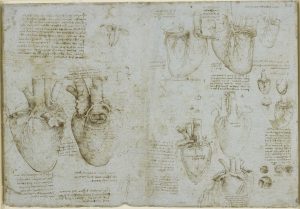
The contractions of the ventricles, the passage of the blood in the aorta, the function of the vein and the pulmonary artery formed for him the object of careful study. He made experiments on the heart of live animals and observed the pulsations on a pig, to which he had inserted large pins into the heart’s thorax.
Although he had reflected on the circular movement of the blood and had the intuition of the capillary veins, which resumed the arterial blood and brought it back to the heart, he was unable to clarify the return of blood from the right ventricle to the left through the small circle. Leonardo could not overcome the errors of Galen’s theories*; some authors believe that, although he sensed that Galen was wrong, he was intimidated by the clash that different theories could have triggered in the circles of intellectuals. The statements of Galen, in fact, were to be considered real dogmas.
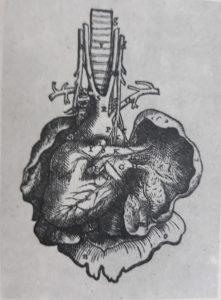
Despite these few gaps, Leonardo’s drawings represent a leap forward in the history of cardiovascular knowledge. As is well known, the drawings and notebooks of Da Vinci were not disclosed in his time: this is the reason that many historians of science trace the success then recorded by Vesalius. If Leonardo’s work had been known, however, many claim, that of Vesalius would have passed into the background.
*Galen made two major mistakes regarding cardiovascular physiology:: the porosity of the septum and the systolic reflux. This indicates that Galen was very far from the dynamic concept of circulatory function. He believed that the venous and arterial system were two closed systems independent of each other, he had not thought about the existence of the small and the great circulation through which blood, with a circulatory movement, starts from the heart and returns to the heart.